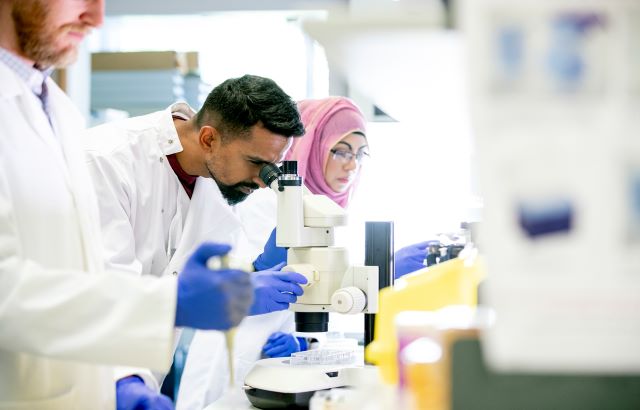
Person in scientific research lab looks into microscope
In the study, published in Nature Communications and led by the University’s Vice Principal for Research, Professor Andrew Livingston, the collaborative team looked at how to improve a process known as ‘PEGylation’.
PEGylation involves a polymer called poly(ethylene glycol) (or PEG for short) being attached onto a drug (usually a biomolecule like a protein) to help them stay in the bloodstream for longer, and to stop the chances of the body’s immune system rejecting them.
However, the process isn’t without its issues. The usual way of making the PEG used for PEGylation agents, always results in a mixture of different sized PEG molecules combined with each other. While this might not seem like a big thing, the impact of different sized PEGs can and does cause difficulties in figuring out where the PEG has attached to the drug, and so there are is a high chance of inconsistencies in how a drug or treatment works and how effective it is from one batch to another.
“This clearly is less than ideal,” explains Professor Livingston. “With our research, we aimed to find a way to create a PEG molecule of a single, specific molecular weight, and which can be produced in large quantities. If we could do this, we could make the PEGylation process more consistent, reduce batch variation and improve drug efficiency.”
By bringing together researchers from the University’s School of Engineering and Materials Science, and Queen Mary’s Barts Cancer Institute, this study merged chemistry and medicine and found a way to improve PEGylation.
“I’m proud to say we succeeded,” continues Professor Livingston. “In our work we were able to create a PEG molecule of a specific, consistent size, meaning we were better able to control the PEGylation process. This in turn means we can better develop, produce and analyse PEGylated drugs and ultimately, we are working on improving how well they work.”
Cross-discipline research collaborations are becoming more and more important to driving both scientific progress and innovations that create new products, and results like these show there’s clear benefit in this.
“As someone working in the school of engineering and materials science, it’s not always clear how my work might be of interest to colleagues in the faculty of medicine and dentistry,” explains Dr Maria Burggraef, a postdoctoral researcher at Queen Mary. “But by working with Andrew and Pedro in this way, by bringing two different disciplines together, we’ve found a way to improve PEGylation, which I hope will have a positive impact on drug development in the future.”
“It’s often easier for researchers to work with others in their area, people they know,” continues Professor Livingston. “What our work shows is that by branching out, working with new people in different fields, you can push the boundaries of your research farther and have more of a positive impact.”
This research was carried out in collaboration with Exactmer Ltd.



